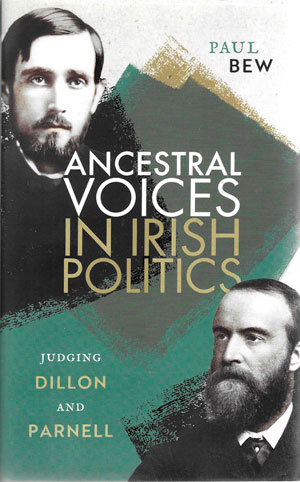PAUL BEW
Oxford University Press
£25
ISBN 9780192873705
Reviewd By Eoin Dillon

Eoin Dillon is a scholar of twentieth-century African history.
In his opening remarks, Paul Bew mentions his personal affinity with Charles Stewart Parnell and John Dillon. His mother had gone to the same medical school in Dublin as Dillon, and the family farm in Cork was called Avondale after Parnell’s homeplace, a tribute from a member of the Irish strong farmer class to their tribune. Bew also mentions his own membership of the House of Lords for fifteen years and Dillon’s membership of the House of Commons for thirty-six.
If history must not be written with an eye on the present, it can be read with a strong sense of contemporary relevance. Many of the themes running through this book north and south are as present today as they were then: the feasibility and durability of a devolved Home Rule state in Northern Ireland; a unitary Irish administration; a land war then, a housing crisis now; a disaffected southern nationalist vote abandoning its traditional political (Irish Parliamentary Party, Fianna Fáil, Labour) allegiances for Sinn Féin, brought about in part by a popular sense that the leadership had got too close to the metropolitan élite; conscription then, neutrality now. But there are differences: a transformed southern Ireland; a greatly reduced and isolated United Kingdom, itself in danger of sundering again. This isn’t history repeating itself; it’s history as continuum.
Writing about Parnell requires no explanation or justification; writing about John Dillon does. Since F.S.L. Lyons’s 1968 biography there has been no major re-evaluation; he doesn’t figure in the historical imagination, though his cousin Val Dillon, lord mayor of Dublin and friend of Molly Bloom, makes it into Ulysses. Bew explains his eclipse by changes brought about in Irish historical attitudes by the troubles in Northern Ireland. Davitt’s social radicalism elevates him. Redmond and O’Brien’s conciliatory attitudes to those beyond the nationalist camp make them attractive to some. Healy’s astringent articulation of Irish Catholic bigotry confers recognition. Like many committed politicians, Dillon cleaved to a core analysis while remaining eminently fluid at any given moment. He was difficult to categorise.
Bew summarises Parnell’s programme for a new Ireland as a place with a prosperous countryside of improving new holdings governed by a local legislature empowered to encourage native industry. Parnell, with his own financially rickety estate and moves into wood production and masonry for construction, fits into this; so does his conception of the role of at least younger landlords as potentially economically progressive. Parnell and Dillon appeared on the same platforms and articulated a deep hostility to the British government and the demand for an Irish legislature in similar terms but were nonetheless, in Bew’s view, very different people. Parnell’s people were ultimately limited to his class; Dillon’s people were the Irish. Parnell might represent them; Dillon embodied them: he was much closer to a visceral sense of suffering. After Parnell, Redmond may have been the public face of the parliamentary party; it was ‘Dillonism’ that dominated it.
Parnell’s thinking was ultimately more attuned to a conservative compromise; Dillon sought the destruction of the Protestant landlord class. When, in Bew’s phrase, Parnell undertook a new crypto-Tory theme, Dillon rejected any compromise with the landlords:
‘I learned to hate them because I saw they had this country by the throat. I came to hate them because I saw throughout all the long time since they were planted here by William III and by Cromwell they never showed the faintest interest in the welfare of the country: and I learned to hate them because I know wherever the name of Ireland is held up either in England or foreign countries to opprobrium and derision … you are almost sure to find an Irish landlord, or some stripling who will become a landlord, in the very foremost of Ireland’s foes. I learned to hate them because I read and saw with my own eyes that every effort in favour of Irish nationality was stamped and crushed out with all the savage brutality of a class who knew they were hated by the people and who knew that hatred was just.’
Parnell, it might be said, was pursuing a strategy of conservative modernisation: everything changes so as much as possible remains the same. Dillon’s was a strategy of social revolution, the downfall of a part of the dominant groups, rise of at least part of the subordinate ones. This was in no sense a simple anti-Protestant bigotry. As Bew notes, Dillon had attempted in 1879 to moderate the Land League programme to include the Presbyterian tenant farmers of the north; resisted in 1909, on the grounds that it discriminated against the ‘Protestant boy’, drives to make the Irish language a requirement to matriculate to the National University; and opposed any efforts to coerce northern Protestants in 1914.
Bew sees as central to Irish nationalism its relationship to liberalism. Liberalism is a protean concept: Dillon was a liberal until it clashed with his nationalism. Perhaps if some politicians in Fianna Fáil and Labour had paid him more heed they wouldn’t be in their present predicament. A final word: Dillon’s uncompromising stance on landlordism brought Ireland to (free) statehood with a land settlement in place; that is a world-class achievement.
